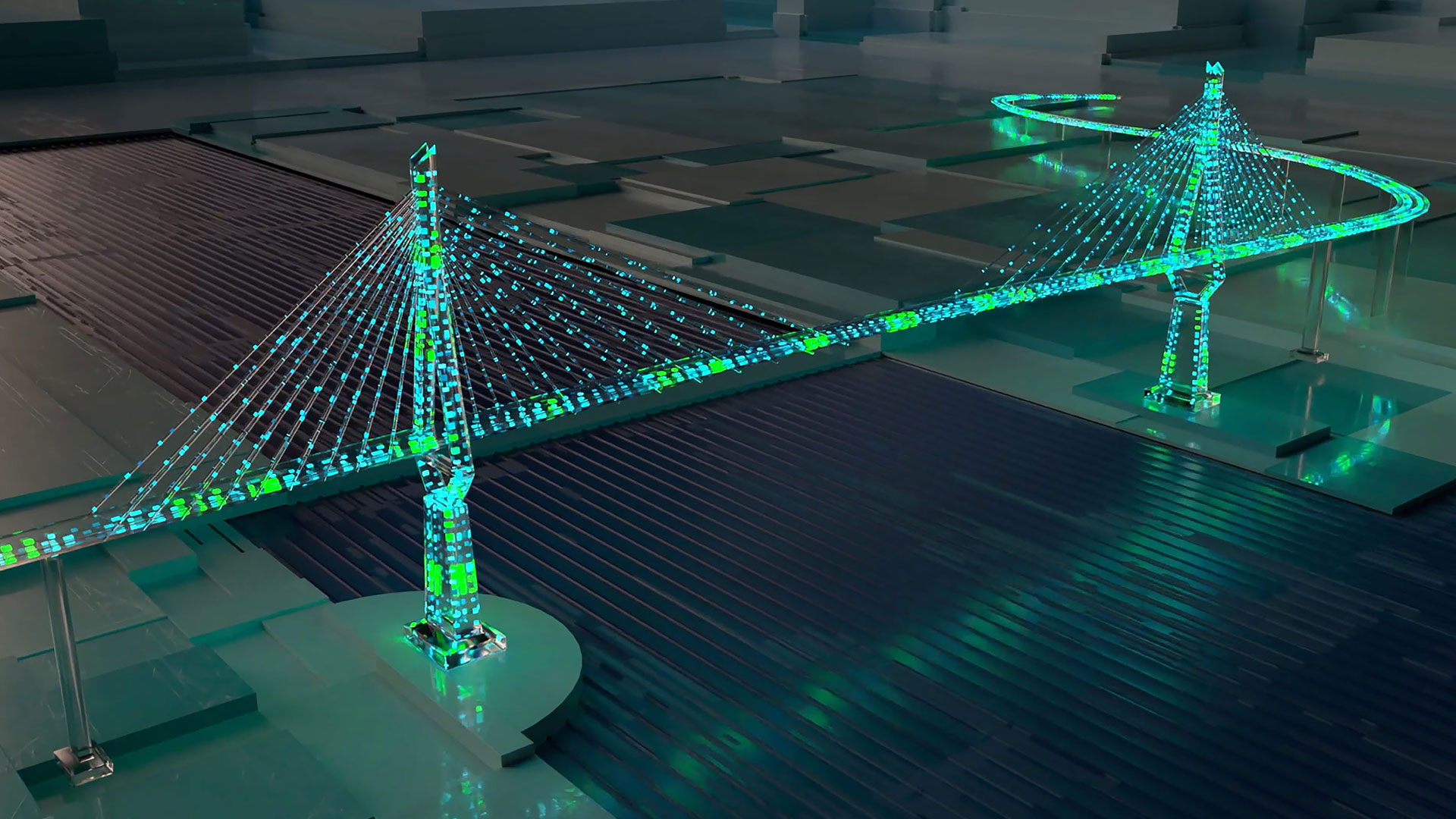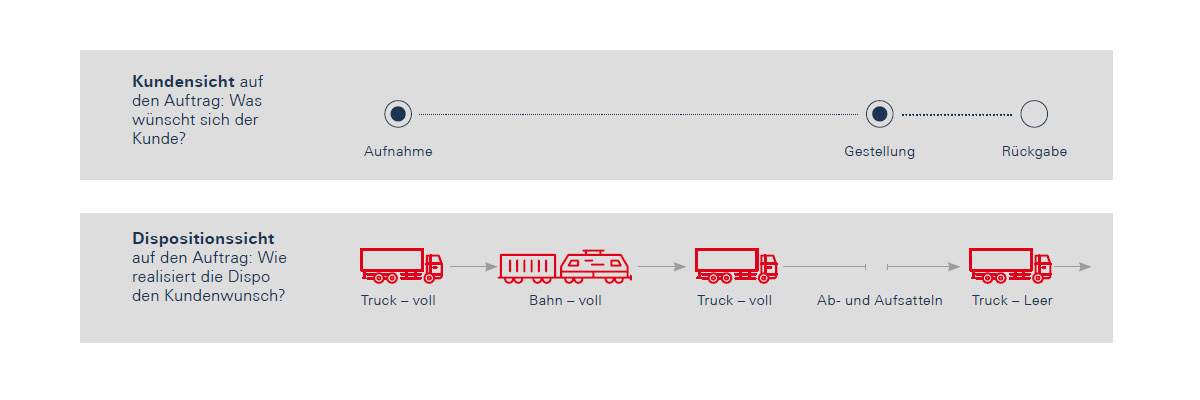Reliable data at any time
Coffee bean specialist NKG Kala uses a digital yard manager. Radio and manually completed lists belong to the past. ...

The Köhlbrand Bridge is a Hamburg landmark and the backbone for industry and transport in the Elbe city’s port. With a length of 3.6 kilometres, the structure is suitable for the job, but meanwhile also high-maintenance, being almost half a century old, i.e., no longer young. Catering for up to 38,000 vehicles a day, it also has much to cope with. The diagonal cable bridge has accordingly been given a digital twin. “We have embarked on this pilot scheme in order to tackle problems arising from our operative business,” says Christof Ullerich, the civil engineer who heads the Bridges and Structures Competence Centre for HPA – Hamburg Port Authority.
What is a digital twin? To put it simply, this consists of a data clone of a real object, based on electric sensors. One of these would identify essential maintenance and repair jobs, for instance on the Köhlbrand Bridge in the Port of Hamburg. “We launched the ‘smart Bridge’ project about three years ago. This has meanwhile become a large-scale demonstration of preventative maintenance and automated traffic control,” says Ullerich, responsible at HPA for innovative projects. For the one on the bridge, 520 sensors were mounted, among other things to provide condition monitoring. “The sensors enable us to see what is going on out there. This helps us to assess the situation far better,” he adds. The structure is displayed as a BIM, or Building Information Model that pools data flows. Analogue data like the findings of structural examination under DIN 1076, and digital data from continuous monitoring by sensors, are assembled and analysed there. “If the sensors produce a spike when a truck thunders across the bridge, roughly speaking this resembles an ECG measuring heart rhythms when somebody rushes upstairs.” Everything should then settle down again. “Like the doctor, we record the vital parameters of our bridge,” explains the engineer.

The clone should minimize downtime and make costs as well as maintenance jobs easier to plan. The sensors are therefore attached at critical points, for example on the bridge’s diagonal cables. These acoustic sensors capture the sound produced by vibrations of the cable. Should this change, that suggests that something is wrong. So, somebody is sent there to check whether all is in order. “When we launched the project, it was caused by problems with the Köhlbrand Bridge,” explains Ullerich. With funding assured, HPA was actually able to tackle this major project.
The bridge ramps are of concrete and the middle section of steel, making the range of lessons to be learned extremely wide. “We wanted to fully exploit the limits of what is possible, using a digital twin,” he says. The result is that the sensors permit an individual view of every structure and receipt of measurement findings as firm facts. The engineers are then far better able to assess what needs to be done at which point, meaning that in the case of the bridge, it does not always need to be closed immediately to traffic, should a problem arise. These announce themselves, as the example of the acoustic sensors on the steel cable demonstrates. Until now, from time to time an inspection team have had to put on their climbing boots.
Yet the ‘Digital Twin’ topic goes far beyond the ‘smart bridge’. HPA is pursuing the vision of developing a Digital Port Twin, or a digital twin of the entire Port of Hamburg. A host of individual twins are already out there. The Elbe has one, for example. This shows how deep it is at which points, and where sediment needs to be dredged off. “We know the state of the tide, the current – everything is measured by sensors,” explains Ulrich Baldauf, an information specialist responsible for Research & Development at HPA. In addition, all ship movements are known through AIS – the Automatic Identification System, along with the times required for the cargo discharge. This facilitates optimization of processes. “We also have a twin of the road traffic,” he says. This in its turn knows the score on traffic and the state of the roads in the port.
Until now, all these clones have simply been used individually. “However, we see great potential for combining all the individual twins in a Total Port Twin,” says Baldauf. “The aim would be to establish what impact, for example, a delayed ship arrival or a bridge closure makes on road traffic or emissions. It should be possible to create overarching monitoring and to specifically intervene where something is occurring.”
The HPA also wishes to use this data for strategic port planning. Differing scenarios, for instance, can be simulated for the utilization of a new area, e.g., whether it would make more sense to build a hydrogen or a container terminal there, or better to put up a warehouse. Each case would have differing repercussions on marine and road traffic, costs and emissions. These can be calculated in advance.

Similarly, this technology is already in use outside the port. For instance, the relatively new company Railwatch from Bonn has developed a measuring system that can conjure up the twin of a freight train – while this is passing. The background: Normally, a wagon master is expected to march up and down all sides of freight trains standing ready to depart from a terminal, whatever the weather, and to check them manually for damage. If he detects something wrong, then the freight car affected needs to be shunted out of the 600-metre train – a time consuming and cost-intensive process.
“Along the track, we can scan trains at a distance of up to eight metres and use HD photos to discover the technical state of the locomotives or freight cars,” says Tobias Frede, COO/CTO for Railwatch. On arrival, a damaged wagon will no longer even be positioned for the onward journey. In Europe’s public rail network, the company has already installed 25 of its ‘Pulsar’ measuring systems. These can also recognize UIC wagon numbers and lettering and hazardous goods warning panels.
“To be able to create a digital twin, we require all the details of a wagon, the number of axles and distance between them, and goods loaded, which our system digitalizes and automatically captures during transit,” explains Frede. For instance, this enables Railwatch to calculate how long a brake block will still last before needing to be changed. “The system also determines whether a wheel rim includes a flat spot,” he adds. This is discerned acoustically, since if a wheel is making a din, then something is wrong. The digital twin supports the wagon master in his work. He is notified of any cases of damage discovered, so that he can localize these more rapidly. He then decides whether the wagon needs to enter a workshop or can remain in service. Railwatch stations stand along the route on private land, without needing to have any link with infrastructure, i.e., tracks. The equipment is erected within four hours and simply require an electric power connection,” he adds. Railwatch uses the mobile radio standard 5G, this enables data captured to be rapidly transmitted for processing to the company’s own Cloud. The Pulsar is equipped with a special camera and sensor technology for the purpose. On commission, the company will also install its measuring stations at the entrances to industrial sites, seaport terminals or frontier crossings.
Last year, for example, Railwatch joined HHLA’s rail operator Metrans Rail Germany to launch the ‘DigiTwin’ field test on digital backing for investigation into freight car technology. “This ‘DigiTwin’ enables us to push on with digital transition in railborne freight traffic,” explains project manager Frede. Under its ‘The Future of Railborne Freight Traffic’ program, the BMVI or Federal Ministry of Transport and Digital Infrastructure is providing funding of around 3.5 million euros. The experiment will continue until end-2023.
Digital twins also exist already for road freight traffic. Cargo Support of Nuremberg, specializing in flexible digital solutions for freight transport, has one software program in its portfolio capable of processing all relevant data in real time. “We have developed a tour model that reflects the actual transport and remains dynamic at all times,” explains CEO Volker Hasch. The model presents the entire supply chain, from truck via rail to ship movements, and covers customers and recipients along with the Customs. “Here the digital twin reflects the reality of all movements, he adds .
The reality needs to be individually set up for every shipment and can change during a tour whether because of provision for an additional stop or the need for a truck to take another route on account of a road closure. If a ship arrives late, that also has repercussions for planned truck movements. “Then the movements clerk needs to react at extremely short notice,” says Hasch. The task of the digital twins is to monitor and check separate sections of the shipment. This is done by locating the load unit or truck, the train and ship, but also through truck drivers able to notify current status with the cargo support app. “With even the slightest discrepancy, the digital twin notifies the movements clerk so that he/she can decide what should be done next,” explains Cargo Support CEO Hasch. With many shipments, it has meanwhile become impossible for the clerk to notify every customer by telephone. In possession of all the assembled data, the digital twin can intervene. Whether the user consults the Cargo Support app, or his own systems, is immaterial. All data, even from external systems, can be transmitted to the digital twin.
The digital twin can also be used for simulating shipments, for example to ascertain on which routes it is better to use rail, where the aim is to reduce CO2 emissions.